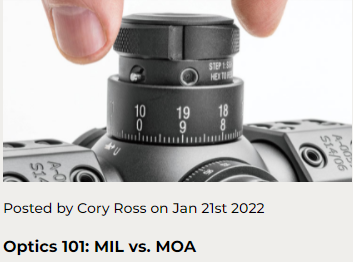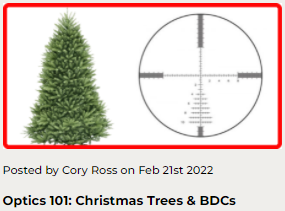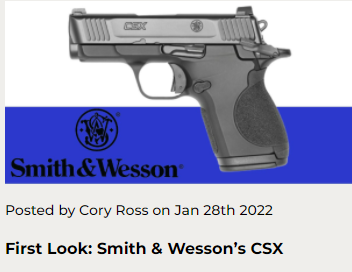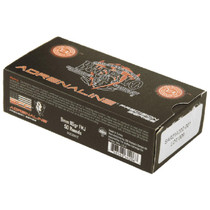Riflescopes 101: Executing the Objective
Posted by Cory Ross on Mar 21st 2022

Introduction:
Optics 101 takes readers on the journey of understanding the ins and outs of riflescopes. Of any area in the gun world, optics may have advanced the most over the past two decades. With the proliferation of PRS (precision rifle series), long-range hunting, and new, more capable cartridges, the shooter has required more out of their optic. Today, using riflescopes requires more of a crash course than in previous decades. This series is designed to help the user get the most out of their optic and system. The finale of this series focuses on what makes scopes better. Terms like objective bell and exit pupil will be defined along with the optical system of riflescopes in general. To read part one of this journey about Mils and MOA follow this link. Concurrently, for an overview on reticles, click here. Below is a quick follow up of terms and definitions to help understand the complicated nature of riflescopes. Understanding these will help to decipher why some optics are relatively inexpensive and others cost more than your first car.
The Basics
Before diving into the details of riflescopes, a few basic pieces of information need to be laid out. To start, a scope has three optical systems that need to be defined. First, the objective is the portion of a scope forward of the turrets. Second, the erector is the system forward of the eyepiece to the turrets. Finally, is the eyepiece itself. In each optical system are a series of lenses that directs the image back to the human eye.
Another common term used in optics is aberration. This needs to be defined in order to better understand how light transmits. Aberration is the failure of light rays to converge at one focus point because of limitations or defects in a lens . Essentially, when light hits the first lens of a riflescope, the light begins to bend and refract in undesirable ways. A good scope uses tools to fix the aberration in order to create a clear and bright target picture.
Finally, focal plane. The reticle of an optic can be placed in two different focal planes—one forward of the turret assembly and one rearward. A reticle in the rear focal plane (called second focal) maintains a constant size while moving up and down the magnification range. Front focal—or more accurately called first focal plane—optics have reticles that increase and decrease in size proportionally as the magnification is increased and decreased. The importance of understanding the difference is the intended application, which will be discussed in a future Optics 101.

A common myth on riflescopes is that the
larger the objective bell, the more light a scope gathers. This, of course, is
a fallacy. Scopes are not funnels, they can’t break the laws of physics. In
reality, light gathering has everything to do with the number of lenses a scope
contains, the makeup of those lenses, and the coatings placed on them. Increasing
the quality of lenses and their coatings increases the percentage of light a scope
transmits. Remember, once light hits a barrier, in this case a lens, it does
all sorts of wonky things. The components of the optical system help fix these
irregularities.
Scope Objective
Aberration, as defined above, is one of those things that happens. A good riflescope fixes the aberration. Scopes with large objective bells have to work harder to fix aberration because of the harsher angles they create.
To get in deeper, high magnification optics perform well with large objective bells and long main tubes. By that logic, that is why low powered variable scopes (1-6, 1-8, etc.) are very capable with small objective bells and short main tubes. Scopes that have a magnification of 3-9, but utilize a 50mm objective bell instead of the more conventional 40mm bell, are not gaining more comparatively. If anything, the image may “appear” to be better (that has more to do with exit pupil), but the optic is losing depth of field (DOF).
DOF is the equivalent of watching a standard definition TV compared to a 4K UHD TV. The same image is being presented, but on the 4K version, the image has depth and crispness. Going back to the 3-9X40 vs 3-9X50 example, the latter will have poorer image quality and DOF because the manufacturer is not adapting to the aberrations caused by a larger bell in the same length scope. Larger lenses create harsher angles for light to pass through requiring more lenses internally to correct.
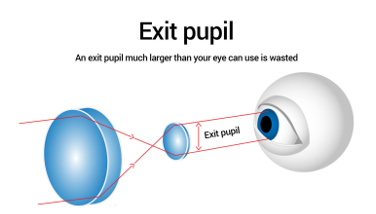
So, when is it appropriate to have a large objective bell? For long range, or PRS style shooting, a 5-25 with a 50-56mm objective and long main tube is going to be advantageous. For tactical or off-hand, unstable shooting, something in the LPVO range with a 24-30mm objective is suitable. For hunting, magnification rages of 3-9x40, 2-12x42, and 3-18x44 will work wonderfully as long as the scope is of a quality design.
https://www.longrangeshooting.org/articles/underst...
Exit Pupil
To expand further and go deeper down the rabbit hole of scopes, exit pupil and its relationship to objective bell size needs to be explored. Exit pupil equals the objective bell diameter divided by its magnification. So on a 3-9x40 with the magnification set at its highest power, the exit pupil is 4.44mm. So that begs the questions, what does that mean and why does it matter?
The exit pupil of a scope directly impacts the perceived brightness of an image by the human eye. It is a relationship between the scope and the size of a person’s pupil. A human eye’s pupil in low light can grow from 3mm to 7mm. However, in daytime, when looking through a scope to find targets hidden in shadowy vegetation, the human eye’s pupil narrows to an average of 2.5mm. The better a scope can match the pupil of the eye, the brighter and more defined an image appears. Therefore, the large exit pupil created by a large objective bell will not always create a brighter image because a human’s pupil cannot grow to match it (on a nice sunny day for instance).
In this instance, the aberration created by an objective bell may be a hinderance, unless it’s a scope that has the correct lenses and coating to fix the problem. The downside here is cost. Having a large scope with high magnification and a large objective bell that has exceptional optical clarity are expensive (generally over $2,000)
Exit pupil matters most at twilight and when shooting fast. At low light, the goal is to have an exit pupil match the eye’s pupil (remember, the eye’s pupil increases as daylight wanes). This will allow the eye to use all of the available light transmitted by the scope. However, having a big objective bell doesn’t always offset the negatives. Having a scope with a moderate magnification range and objective size while dialing down magnification will actually increase the exit pupil and maintain good optical quality and image brightness while matching the eye’s pupil. When shooting fast, like 3-gun for instance, dialing down in magnification helps your eye transition from target to target. A better exit pupil gives the human eye leeway when trying to focus as the shooter moves.
Conclusion
The subject of riflescopes is murky and difficult to navigate, especially as the options available to the consumer increase every year. The market almost seems saturated with optics—both good and bad—that the user needs to have a better understating on why one is better than the other. In this series, we have delved into those very subjects to help the user. Starting with MOA vs. Mil, we took a detailed look at the measurement systems a scope uses to identify which one is better for the end user. The second article looked at reticles, specifically BDC and Christmas tree style reticles, to see what scenario is optimal for each. Reticle choice and measurement system are the first steps in identifying what scope a consumer needs. In this last article we looked at why certain scope are better than others while busting myths involving objective size and exit pupil. When buying a scope it is all about having a plan in place. Knowing budget, reticle style, measurement system, and what to look for will help to best enhance your shooting experience.




